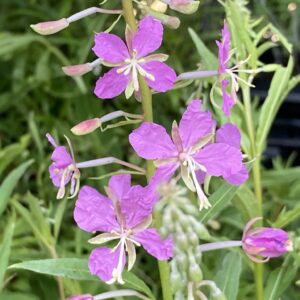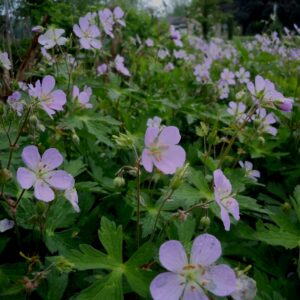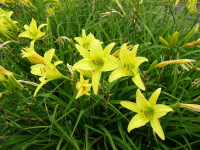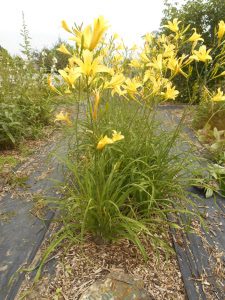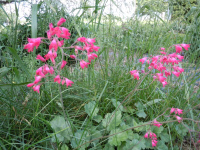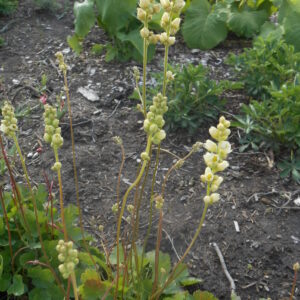Plants for Hummingbirds
Showing 25–32 of 78 results
-
Epilobium angustifolium syn. Chamaenerion angustifolium Fireweed Z 2-7
Bright pink to lilac purple flowers June-July atop red stems covered in willow-like leaves
Bright pink to lilac purple flowers June-July atop red stems covered in willow-like leaves.
Can be slow to establish – be patient!
Size: 2-6’ x 3’ spreading
Care: Sun to part shade in dry to moist well drained soil
Native: Circum-polar to the temperate northern hemisphere. Wisconsin native.
Wildlife Value: Attracts hummingbirds, bees, and butterflies. Host for caterpillars of Fireweed Clearwing moth and Nessus Sphinx mothCommon name comes from its quick reappearance after a wildfire. Native Americans used fireweed externally for burns and other skin conditions, and made a tea for gastro-intestinal and bronchial problems. Its shoots eaten as a vegetable and young leaves added to salads. Fireweed yields a honey so prized that some Canadian beekeepers drive – or even fly – their hives to areas rich in fireweed for the blossoming season. Described and named by 1753.
-
Erythyranthe lewisii syn. Mimulus lewisii Lewis’ Monkeyflower Z 5-9
Bright rose trumpets with hairy yellow throats, flowers all summer
Bright rose trumpets with hairy yellow throats, flowers summer
Size: 2-3’ x 12"
Care: sun to part shade in moist to moist well-drained soil
Native: Alaska to California and as far east as Colorado
Wildlife Value: Nectar for hummingbirds and bees
Awards: Royal Horticultural Society Award of MeritFirst collected by Meriwether Lewis on the Lewis & Clark Expedition “on the head springs of the Missouri, at the foot of Portage hill,” in August 1805.
-
Geranium maculatum American Cranesbill, Wild geranium, Spotted geranium Z 3-8
Clusters of two to five pink infused with lavender, flowers of five, paddle-shaped petals bloom in late spring to early summer.
Clusters of two to five pink infused with lavender, flowers of five, paddle-shaped petals bloom in late spring to early summer.
Size: 24" x 18"
Care: Full sun to part shade in moist to moist well-drained soil
Native: East North America, Wisconsin native.
Wildlife Value: primarily visited by several kinds of bees.Native Americans taught colonists to use the plant to cure diarrhea, dysentery, and hemorrhaging. Also used on sores, open wounds, canker sores and sore feet. The Choctaw prescribed it for venereal disease. Sent to Europe in 1732. Jefferson asked John Bartram to obtain seeds, 1786. Collected by French plant hunter André Michaux (1746-1802). Pressed specimen in Emily Dickinson’s herbarium.
-
Hemerocallis ‘Hyperion’
Midsummer, fragrant lemon yellow trumpets
Midsummer, fragrant lemon yellow trumpets
Size: 36" x 12"
Care: Sun, moist well-drained soil. Drought tolerant.Hybrid origin, bred in 1925 and still popular today.
-
Hemerocallis multiflorus Many-flower daylily in China called duo hua xuan cao Z 4-8
Elegant, tall, upright sunshine yellow flowers on this species daylily
Elegant, tall, upright sunshine yellow flowers on this species daylily. Grow for its height & unrivaled number of flowers. Each scape (leafless stem) will produce up to 100 blooms so that this blooms an extraordinary length of time, July-September
Size: 36-40” x 18-24”
Care: sun to part shade in moist well-drained soil
Native: openings in forests on hills in province Honan at Ki Kung Shan, China
Wildlife Value: attracts hummingbirdsThis species grown by Rev. C. Woolly Dod in Malpas, Cheshire England in 1880, The Garden, an Illustrated Weekly Journal of Gardening. Hemerocallis is Greek meaning “flower for a day.”
-
Hesperaloe parviflora Red Yucca Z 6-9
Cerise scarlet trumpets up and down the flower spike in summer
OUT OF STOCK
Cerise scarlet trumpets up and down the flower spike in summer
Size: 3’ x 5’
Care: sun moist well-drained to dry soil
Native: Europe, west & central Asia
Wildlife Value: Attracts butterflies & hummingbirds. Deer and rabbit tolerant,Named by Dr. George Engelmann, a German physician and plant fanatic who emigrated to America in the early 1800’s, settling in St. Louis.
-
Heuchera sanguinea Coral bells, Alumroot Z 3-8
Coral red flowers in late spring through early summer. “One of the finest hardy perennials recently introduced …bright crimson flowers…very graceful,” Farquhar Catalog, 1893.
Coral red flowers in late spring through early summer. “One of the finest hardy perennials recently introduced …bright crimson flowers…very graceful,” Farquhar Catalog, 1893.
Size: 12" x 12"
Care: sun to part shade in moist well-drained soil.
Native: Western U.S.- Rocky MountainsGenus Heuchera named for Johann Heinrich von Heucher (1677-1747) professor of medicine at Wittenburg University. This species collected Be Dr. Frederick Adolph Wislizenus in the Porphyry Mountains of Llanos Mexico on the Col. Doiphan Expedition in 1846-7. Named by Dr. George Engelmann, (1809-1884) physician and avid botanist encouraging and supporting those who explored for plants. He emigrated from Germany and settled in St. Louis. Plant popular in the 1880’s.
-
Heuchera versicolor syn. H. rubescens var. versicolor Pink alumroot Z 4-10
Tiny pink bells on narrow inflorescence blooming mid to late summer
OUT OF STOCK
Tiny pink bells on narrow inflorescence blooming mid to late summer
Size: 8-12” x 12"
Care: prefers part shade in moist well-drained to well drained soil, can grow in sun with moist soil. Deer resistant.
Native: southwestern US
Wildlife Value: attracts bees, butterflies and hummingbirdsFirst collected in 1904 on damp, shady bluffs of the Black Range in New Mexico, accd. to Edward Lee Greene.
The roots are astringent and can also be used as an alum substitute, used in fixing dyes. Was also used medicinally for fever, diarrhea, venereal disease, liver ailments, eyewash, colic and animal care. Heuchera is named for Johann Heinrich von Heucher (1677-1747), while rubescens means becoming red or reddish, and versicolor means variously colored.

